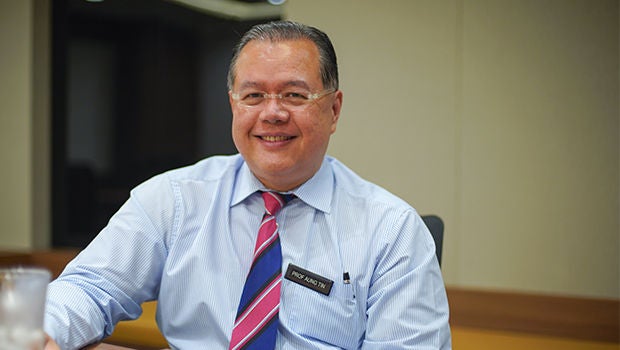
Professor Aung Tin has spent more than two decades treating and researching better ways to prevent, diagnose and manage glaucoma. Recently, the outstanding clinician and researcher from Singapore National Eye Centre (SNEC) and Singapore Eye Research Institute (SERI) was conferred the Kwan Im Thong Hood Cho Temple Professorship in Ophthalmology by Duke-NUS in recognition of his sterling achievements and to enable further research advancements. Prof Aung shares why he chose to specialise in glaucoma and what motivates him to persevere.
What sparked your interest in glaucoma?
When I started my specialist training in ophthalmology in the mid-1990s, not much was known about glaucoma. This was especially true for angle closure glaucoma, which is a form of glaucoma that is much more common in East Asians than Caucasians. So I knew that any progress I made could impact the lives of many people in Singapore and the region.
Glaucoma causes a buildup of pressure in the eye which damages the optic nerve. This ‘silent’ disease is the leading cause of irreversible blindness worldwide and in Singapore, where more than 3.2% of the Chinese population aged 40 years and above has the disease. It can be treated if diagnosed in the early stages but most patients don’t know they have the disease and only seek help when they have narrow tunnel vision left. Unfortunately, at this advanced stage there is little we can do to save their sight so I wanted to improve awareness, screening and detection of this disease.
Early in my specialist career, I also discovered that many of my patients had relatives who suffered from glaucoma. I realised there must be a genetic component to the disease which I wanted to explore. I remember one patient who had relatives living in Australia, Canada, Malaysia and the United States. When I told him that glaucoma often runs in families, he contacted more than 70 overseas relatives and advised them to go for screening. Through this exercise, about 10% were diagnosed with the condition in the early stages which meant they could receive treatment to save their sight.
Tell us more about your research focus
My team and I focus our research on three big questions:
• Who is at risk of angle closure glaucoma?
• How can the disease be picked up through screening?
• If it is discovered in the early stages, how can it be treated to prevent loss of vision?
In angle closure glaucoma, the part of the eye that drains out fluid (the angle) becomes narrow and eventually blocked. This causes the buildup of fluid and pressure on the optic nerve. Through our research, we are improving imaging techniques of the eye to make it easier to detect narrowing of the angle. This may result in more accurate screening programmes, enabling us to better identify people who are at risk of glaucoma.
We’re also currently studying in a randomised controlled trial if laser treatment to widen narrowed angle in people who do not yet have glaucoma would be an effective way to prevent the disease at the population level.
At the genetic level, my team and I are studying several different genes (discovered through our research) that are linked to glaucoma to understand how they cause problems in the eye and to understand the disease biology better.
The fear of blindness is very real for many of my patients because it has a significant impact on their quality of life. This motivates me to keep searching for better ways to prevent and treat glaucoma.
Professor Aung Tin
Deputy Medical Director and Vice Chair (Research)
Head & Senior Consultant (Research, Education and Development), Glaucoma Department, SNEC
Executive Director, Singapore Eye Research Institute
How will this Professorship further your research?
I’m very grateful to the Kwan Im Thong Hood Cho Temple and SNEC for this Professorship because it provides me with more flexible research funding. I’ve been fortunate to have received government grants through the National Medical Research Council to fund my research over the last 20 years, but they can only be used for specific work outlined in the grant proposals. Research often throws up new questions that need to be explored quickly. I can now use funds from this Professorship to uncover answers which could lead to the next sight-saving breakthrough in the fight against glaucoma.














 Get it on Google Play
Get it on Google Play